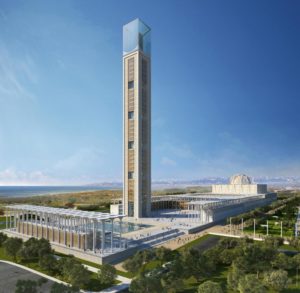330 gas sensors from MSR-Electronic protect against gas hazards in an underground car park with 4,000 parking spaces
A fascinating sacred space opened in the Bay of Algiers at the end of 2020, the third largest mosque in the world after Mecca and Medina. The invited international competition for the architectural design with 17 participants as well as the construction management was won by the German architectural office KSP Engel.
For the country the significance of the project was great. Only a few months after the competition decision, the contract was signed in the presence of the German Chancellor Angela Merkel. The mosque in Algiers is the third largest and thus will be one of the most important mosques in the world in the future.

©Architect’s office KSP Engel
The tallest skyscraper in Africa
In terms of figures: A base with underground parking for 4,000 vehicles forms the common ground. There is room for up to 36,000 people in the prayer hall – St Peter’s Basilica would fit inside – and 120,000 people in the entire complex.
At 265 meters, the minaret is the tallest in the world and the tallest skyscraper in Africa to boot.
The minaret moved away from the central axis is the first minaret in the world to resemble a modern hybrid skyscraper and houses a museum for Islamic culture with a research centre, office areas and a sky lobby.
There is also a viewing platform in the glazed spire.
An underground car park with triple gas monitoring
Whether conventional petrol- and diesel-engined vehicles, electric cars or vehicles powered by LPG; the mosque’s parking garage is equipped with a complex gas warning system from MSR-Electronic. 330 gas sensors monitor the CO, NO2 and LPG concentration in the ambient air, thus ensuring people’s safety.
The Great Mosque of Algiers was also one of MSR-Electronic’s largest projects in 2020.
In underground garages, tunnels and parking halls, worldwide guidelines apply for safe gas monitoring of exhaust gases with gas sensors. First, the ventilation system is ramped up. If this does not sufficiently reduce the concentration of pollutants, optical and acoustic signaling devices warn to evacuate the room.
CO exhaust gases from petrol engines
Carbon monoxide forms during incomplete combustion of petrol. Its proportion is highest during the starting process of an engine. The gas is completely odourless and colourless. At the same time, CO is a highly toxic (poisonous) gas that is lethal even in small quantities. Put simply, the intake of CO hinders the oxygen supply; the transport of oxygen in the blood of the human body is massively impaired. Since humans do not have a sensory organ that protects them from this, suitable gas sensors are used for safe detection.
NO2 exhaust gases from diesel engines
Nitrogen oxide forms during the combustion of diesel. NO2 is a very strong respiratory poison, damages the mucous membranes and irritates the eyes. Moreover, NO2 is responsible for cough, bronchitis and even pulmonary edema. Humans can detect NO2 through their sense of smell, as it smells similar to chlorine. But the concentration emitted by car exhausts is usually not sufficient to be perceived by the sense of smell. Here, too, a gas sensor must be used for reliable detection.
LPG
In fact, parking in an underground car park with a vehicle running on liquid petroleum gas – LPG – is, in the truest sense of the word, dangerous like fire. LPG is heavier than air and forms invisible lakes when it escapes from a tank. This means that there is a high risk of fire and explosion if someone only throws away a burning cigarette butt. But this is not the case when natural gas or hydrogen escapes. These gases are much lighter than air and quickly disappear through the ventilation.
Solutions from MSR-Electronic for reliable gas monitoring
Gas detection systems must be reliable at any time. When gas leaks occur, fast alarms and reliable products are required. The sensors, controllers and warning devices from MSR-Electronic effectively protect people and systems in dangerous situations when combustible or toxic gases escape.
MSR gas sensors are integrated into complex warning systems and are used i.a. in:

©MSR-Electronic GmbH, Germany, CO gas sensor SC2
In addition to the sensor element and the measuring amplifier, the sensors contain a μController for processing the measured values. Thus, various data can be processed and utilised, such as the temperature for compensation of the measured value. Calibration interval and errors are also monitored and transmitted to the evaluation unit.
Thanks to the X-Change technology, calibration can be carried out by simply exchanging the sensor head or by using the integrated, convenient calibration routine directly on the system. The sensors are designed for connection to the MSR controllers and boards.
The entire support and installation of the MSR gas warning system for gas monitoring in the Great Mosque of Algiers was carried out by the MSR partner Daman Tech Safety & Security Technologies. The gas warning system complies with EN 50545, VDI 2053 and EMC Directive 2014/30/EU.
Further information on MSR products can be found in the current online catalog or in the webshop www.msr-24.com.